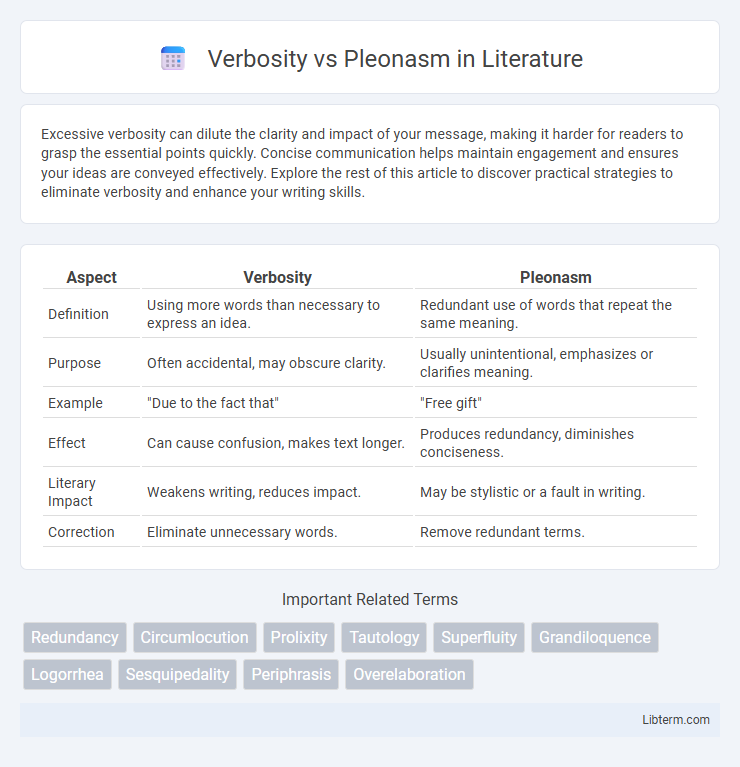Excessive verbosity can dilute the clarity and impact of your message, making it harder for readers to grasp the essential points quickly. Concise communication helps maintain engagement and ensures your ideas are conveyed effectively. Explore the rest of this article to discover practical strategies to eliminate verbosity and enhance your writing skills.
Table of Comparison
| Aspect | Verbosity | Pleonasm |
|---|---|---|
| Definition | Using more words than necessary to express an idea. | Redundant use of words that repeat the same meaning. |
| Purpose | Often accidental, may obscure clarity. | Usually unintentional, emphasizes or clarifies meaning. |
| Example | "Due to the fact that" | "Free gift" |
| Effect | Can cause confusion, makes text longer. | Produces redundancy, diminishes conciseness. |
| Literary Impact | Weakens writing, reduces impact. | May be stylistic or a fault in writing. |
| Correction | Eliminate unnecessary words. | Remove redundant terms. |
Understanding Verbosity: Definition and Examples
Verbosity refers to the use of more words than necessary to express an idea, often leading to wordiness that dilutes the core message. Examples include phrases like "due to the fact that" instead of "because," or "in the event that" instead of "if," which unnecessarily expand sentences. Recognizing verbosity is essential for clear and concise communication, as it helps avoid redundancy and improves readability.
What is Pleonasm? Exploring Redundant Expressions
Pleonasm refers to the use of more words than necessary to convey meaning, resulting in redundant expressions that do not add information. Examples include phrases like "free gift" or "advance warning," where one word already implies the other. Understanding pleonasm helps improve clarity and conciseness by eliminating unnecessary repetition in writing.
Key Differences Between Verbosity and Pleonasm
Verbosity involves using more words than necessary to express an idea, often leading to lengthy and unclear communication, whereas pleonasm specifically refers to the redundant or superfluous use of words that repeat the same meaning. Verbosity affects overall sentence length and clarity, while pleonasm targets unnecessary word repetition within phrases, such as "free gift" or "advance warning." Understanding these distinctions enhances concise writing by eliminating excessive language and redundant expressions.
Causes of Verbosity in Writing
Verbosity in writing arises primarily from the excessive use of unnecessary words, redundancy, and over-explaining simple concepts, which dilutes the core message. Common causes include a lack of clarity in thought, an attempt to sound more formal or authoritative, and insufficient editing or revision processes. Pleonasm, while related, specifically refers to the use of redundant expressions that add no additional meaning, often stemming from habitual phrase usage or linguistic style rather than mere wordiness.
Common Pleonasm Phrases and How to Avoid Them
Common pleonasm phrases such as "free gift," "advance planning," and "unexpected surprise" contribute to redundancy and dilute the clarity of writing. To avoid pleonasm, writers should carefully evaluate each word's necessity and remove redundancies that do not add meaning or emphasis. Practicing concise language enhances readability and ensures communication is efficient and precise.
The Impact of Verbosity on Communication Clarity
Verbosity often leads to reduced communication clarity by introducing unnecessary words that dilute the core message, making it harder for the audience to grasp key points quickly. Unlike pleonasm, which involves redundant expressions, verbosity expands content length without adding meaningful information, increasing cognitive load and causing reader fatigue. Clear and concise language improves comprehension and retention, essential for effective communication in professional and academic contexts.
Why Pleonasms Weaken Writing Effectiveness
Pleonasms weaken writing effectiveness by introducing unnecessary redundancy that dilutes the core message and burdens the reader with superfluous information. Unlike general verbosity, pleonasms repeat ideas using different words, which creates confusion and decreases clarity. Eliminating pleonastic phrases strengthens communication by fostering precision and enhancing the impact of the text.
Techniques to Reduce Verbosity and Pleonasm
Techniques to reduce verbosity and pleonasm include eliminating redundant phrases, such as "advance planning" or "free gift," which convey the same meaning with fewer words. Employing precise vocabulary and active voice enhances clarity and conciseness, minimizing unnecessary repetition. Utilizing tools like editing software and peer review can also effectively identify and remove verbose or pleonastic expressions in writing.
Benefits of Concise and Precise Language
Concise and precise language enhances communication by reducing verbosity and avoiding pleonasm, which leads to clearer, more impactful messages. This efficiency saves time for both the writer and the reader while minimizing misunderstandings often caused by redundant or excessive wording. Effective use of concise language improves readability and ensures that key points are easily retained.
Verbosity vs. Pleonasm: Striking the Right Balance
Verbosity involves using more words than necessary, often leading to redundancy without adding meaning, while pleonasm specifically refers to the use of superfluous words that repeat the same idea, such as "free gift" or "advance warning." Striking the right balance requires eliminating unnecessary repetition while maintaining clarity and emphasis, ensuring communication is both concise and effective. Skilled writers achieve precision by avoiding excessive wordiness and redundant expressions, enhancing the impact and readability of their message.
Verbosity Infographic

 libterm.com
libterm.com